William Friedkin
BY ROB FELD
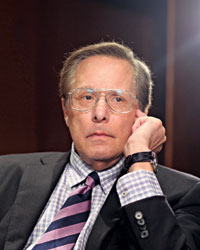 INNOVATOR: William Friedkin says the first
INNOVATOR: William Friedkin says the first
and last image of the film underlines the
sense of irony that runs through it.
(Photo courtesy of William Friedkin)
The room darkens in William Friedkin’s screening room as he settles into a couch to watch Orson Welles’ seminal work, Citizen Kane (1941), for an estimated 151st time. He’s excited to pro- ject the newly released Blu-ray, which presents the cleanest print of the film he’s seen since he first encountered it in 1955 at the art house Surf Theater in Chicago. Up until that point, Friedkin had experienced only Saturday afternoon serial movies. He was working in the mailroom of WGN-TV and someone recommended he go see the theatrical re-release of Kane.
“I entered the Surf at noon and I didn’t get out until midnight,” Friedkin recalls. “I saw it five straight times and it was a profound experience that led me to believe film could have a great influence on people’s lives.”
Citizen Kane was Welles’ first film, made when he was 25 years old and under an unprecedented full-control contract with RKO Pictures, granted to him based on his brilliance as a creator of radio and theater productions. Kane’s story was largely inspired by the life of newspaper mogul William Randolph Hearst, who famously crushed the film commercially in his chain of newspapers.
After the silent opening credits, we enter a shadowy world introduced by foreboding horns and a fade to a dirty “No Trespassing” sign. The camera cranes up a series of fences to reveal a matte painting of Kane’s mansion, Xanadu, in the foggy distance, beyond an iron gate with a monogrammed “K.”
“Bernard Herrmann’s score sets the mood immediately for mystery and tragedy, and the first image sets the tone,” says Friedkin, excited once again by the film. “You are going somewhere where you should not be going.”
Welles himself plays Charles Foster Kane, whom we meet in his dying moments when he drops a snow globe to the floor and whispers perhaps the single most famous word in film history, “Rosebud.” Friedkin notes that the word was recorded twice by Welles and offset to achieve an echo effect.
Welles cuts to a close-up of the globe. “Somewhere between 50 to 80 percent of this movie is comprised of special effects shots,” Friedkin continues. “Optical printing, double exposures, miniatures, matte paintings. Welles experimented with the technical innovations that had emerged about a year or so before he made the film. He wanted the camera to move to an extreme close-up of the snow globe but the ball was too small. Linwood Dunn, inventor of the Acme-Dunn Optical Printer, had the idea to superimpose snow over the outside of the snow already falling in the ball, to cover the film grain and optically zoom in. It would have been a highly grainy shot, otherwise, and almost nothing in Kane is grainy.”
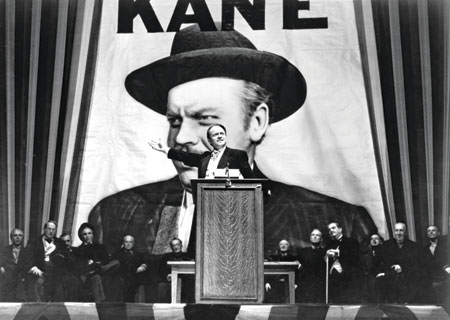 Welles emphasized details to suggest far more than was actually there. (Photo: Photofest)
Welles emphasized details to suggest far more than was actually there. (Photo: Photofest)The one exception is the “March of Time” pastiche of newsreel footage Welles uses to lay out the broad details of Kane’s life. “They actually dragged that negative on the ground to degrade it and make it appear to be stock footage,” says Friedkin. The footage covers some 50 years of Kane’s life, showing his rise as a titan of yellow journalism, and then his fall into irrelevance and obscurity. Friedkin again responds to the energy, inspiration, and invention Welles brought to the film.
“These shots are so offhand that you believe you’re looking at a newsreel about a real person. And here’s an unusual shot for the day,” he points as a handheld camera with a long lens captures through a fence the elderly Kane being wheeled by a butler. “This sequence looks like it was shot by a hidden photographer without permission. Also, the makeup is totally believable, invented for this picture by Maurice Seiderman, who was a nonunion makeup artist sweeping the floors at RKO when Welles found him experimenting with pieces of latex for makeup, which is now common practice.”
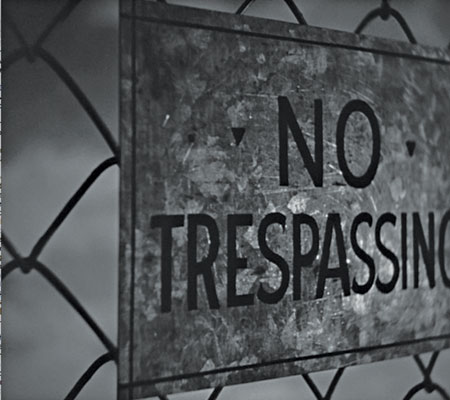 The first shot of Citizen Kane. (Screenpull: Warner Bros.)
The first shot of Citizen Kane. (Screenpull: Warner Bros.)The newsreel abruptly ends on Kane’s death and Welles quickly cuts into a dark, smoky screening room where the newsreel projector groans to a stop. Journalists only silhouetted by the light pouring from the projection booth ponder the meaning of Rosebud and the mystery of Kane’s life in overlapping dialogue, and the nearly faceless reporter Jerry Thompson (William Alland) is assigned to investigate. Thus the conceit of the film takes the form of a mystery, but Friedkin notes that it belongs to no particular genre.
“You don’t see the characters’ faces and, in reality, the projector would have been shut off, so those arc lights pouring from the booth are an impressionistic element,” he points out.
 As journalists watch newsreels of Kane’s life, they are silhouetted by the light pouring from the projection booth.
As journalists watch newsreels of Kane’s life, they are silhouetted by the light pouring from the projection booth.
(Screenpull: Waner Bros.)As the journalists move through the beams like shadow puppets, Friedkin talks more about how Welles harnessed light to achieve the effects he did. “His cinematographer, Gregg Toland, had a hand in inventing the 24 mm Cooke lens they used for most of the film. It was coated with magnesium fluoride to allow more light to enter, so they could stop-down the lens and achieve deeper focus. They also used Eastman Kodak’s new, fast Super-XX film and brought back arc lights, which had long been out of use. They throw a powerful beam and a beautiful light, and Kane is one of the very few films to really make use of it.”
The journalists conjecture that Rosebud will “probably turn out to be a very simple thing,” and Welles cuts to a billboard of Kane’s second wife, singer Susan Alexander (Dorothy Comingore), in a thunderstorm. “This cut has a powerful effect,” Friedkin says. “It feels as though the heavens are opening and that Rosebud will not turn out to be a very simple thing, as the camera moves up and forward, through the skylight and into the nightclub, acting as our guide through a labyrinth.”
Welles keeps Thompson’s back to the camera as he tries to persuade Susan to speak to him. “You never see Thompson’s face, you never see him lit,” reminds Friedkin. “He’s a subjective figure, like the camera. He represents the audience.”
Here Friedkin points out that Welles positioned the recently invented Mitchell BNC 35 mm camera, which was self-blimped and therefore silent, close to them to capture the intimacy of the scene on this small set. “Welles and Toland wanted to maintain deep-focus photography, but some of the sets were small,” he says. “The BNC let them use the wide-angle lens to show more information in focus and still get close to the characters, without picking up camera noise. Also, because the camera was smaller, it could be more easily moved when mounted on a crane.”
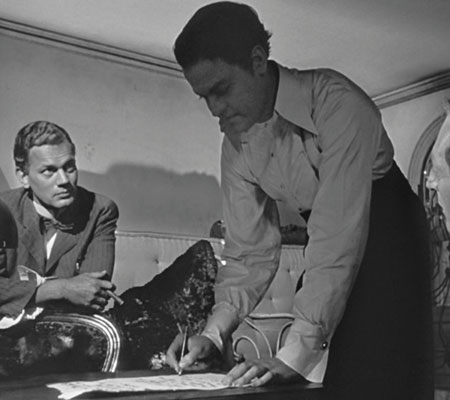 Kane writes a manifesto at his newspaper but Welles boldly kept his face in shadows while he did it. (Screenpull: Waner Bros.)
Kane writes a manifesto at his newspaper but Welles boldly kept his face in shadows while he did it. (Screenpull: Waner Bros.)Thompson next visits the library of Walter Parks Thatcher (George Coulouris), the banker who raised the young Kane when his parents sent him away. Thompson is there to read Thatcher’s memoirs, inviting Welles’ first shift in storytelling perspective. “What Kane attempts to do structurally is cubistic: It presents multiple viewpoints of the same incident and man. And here the arc light is in its greatest glory,” says Friedkin, observing shafts of light streaming into the dark reading room. As Thompson sits down with the diary, its words dissolve into snowfall and the wind and string sections of Hermann’s score lead Thompson back in time.
“Listen to how the music is curious through this transition into Thatcher’s diary. The score is telling you how to think, which is against what I typically feel is the proper use of a film score. But here it’s so well integrated that it meshes perfectly with all the other aspects of the film; the cinematography, editing, special effects, makeup, acting, script. All these artistic contributions are inseparable, which is the genius of Kane. And it’s also why it’s a film by Orson Welles; other people made serious contributions to this film—[writer Herman] Mankiewicz, Toland, all of them—but it’s the vision of one person that brought them all together in this way.”
The perspective shifts again when Thompson finds Mr. Bernstein (Everett Sloane), the original managing editor of Kane’s New York Inquirer, and he relates Kane’s idealistic early days as a newspaper publisher. We see Kane telling his staff that he needs to make the paper as important to New York as the gas in a lamp, which he pointedly turns off, leaving his face in darkness while he writes an inspiring manifesto.
“That’s a telling gesture, turning it off instead of on,” Friedkin says as he leans back on the couch. “And to take the central figure’s face and put it in shadow so you are drawn more to it than the other characters! You’re trying to perceive his expression, but you can’t. Welles was deeply influenced by German Expressionism. Kane was described as cold by some of the critics, but I find it deeply moving.”
When Thompson tracks down Jedediah Leland (Joseph Cotten), Kane’s old friend and the Inquirer’s drama critic, he hears the story of Kane’s failed gubernatorial bid and marital breakup as a result of his affair with Susan. “You can see now how gradually Welles has modulated his voice to sound older,” says Friedkin, shifting in his seat as Kane gives a campaign speech. “He’s acting with everything an actor has: appearance, voice, movement.
They had no set at all other than that platform, lectern and poster behind him, so Welles emphasized details to suggest far more than was actually there, while you still hear his voice echoed. It’s radio technique, throwing the voice so it sounds like it’s coming from a different perspective, close or far away; perspective sound as well as perspective image.”
At the campaign speech, Kane’s first wife Emily (Ruth Warrick) is given a note from Kane’s opponent, James Gettys (Ray Collins). Following its instructions, Emily takes Kane to Susan’s apartment where Gettys awaits, threatening to expose the affair if Kane doesn’t withdraw. Friedkin jumps in to narrate the confrontational sequence that he still finds thrilling.
“The lighting is mostly single source and from the side, as usual. They couldn’t light from above because they had muslin cloth ceilings concealing microphones—seeing a ceiling was rare in those days but subliminally you believe you’re in an actual room where there’s always a ceiling. Welles staged his scenes for what the arc light could do; it’s hitting Kane and Susan hard, and Toland used a bounce card off to the left to light Gettys.”
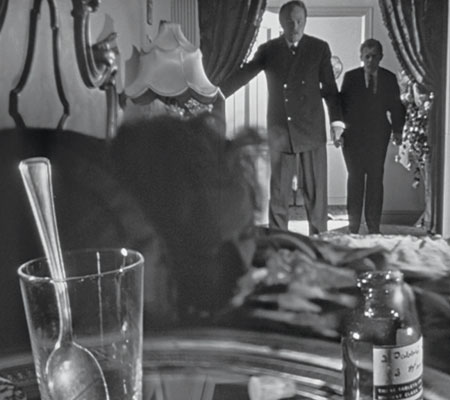 Welles did the scene of Susan overdosing in a “triple matte shot." (Screenpull: Warner Bros.)
Welles did the scene of Susan overdosing in a “triple matte shot." (Screenpull: Warner Bros.)Kane shouts after Gettys that he’ll send him to Sing Sing, as Welles cuts outside the building. “Listen to the sound transition. The words ‘Sing Sing’ blend immediately into a distant car horn. Welles, 12 years after the invention of sound in film, took these radio techniques and innovated to the point of making something totally original in film that’s influenced every filmmaker since.”
After he marries Susan, Kane grows unreasonable and even cruel. He builds an opera house where he insists she perform, and refuses to let her stop despite horrendous reviews. Trapped and humiliated, Susan overdoses and Kane finds her in bed in what Friedkin refers to as a “triple matte shot,” which incorporates three planes of full focus.
“In the foreground is a glass and some pills,” Friedkin explains, “so you can see what she tried to do to herself. In the middle ground Welles enters the room, and the butler is in the deep background. All are in sharp focus but Welles is not actually playing the scene with her. They first shot the foreground with the glass and pills, blocking out the whole middle ground and background. They shot these three elements separately in the same locked frame, and combined them in the optical printer.
“In virtually every scene in Kane,” Friedkin continues, “the foreground, middle ground, and background are in equal focus. It’s described as realism but to me the photographic technique is expressionist; in life we don’t really see all things in absolute focus. The technology allowed for the visual style of the picture but it’s all in service of telling a great story that has meaning and reverberation.”
When Susan finally leaves Kane in an unused nursery in their castle, Welles uses a deep-focus matte shot to show the perspective switch over to the butler, who watches from the deep distance Kane framed by a doorway.
“This is an incredible matte,” Friedkin enthuses. “Kane is standing in the doorway as a reduction. They filmed him, then reduced the size of his image in the optical printer before combining it with the matte of the hall in the middle distance, with Kane’s shadow painted on the floor.”
In a rage, Kane impulsively trashes the nursery in one take, captured by two cameras. Friedkin shakes his head. “I’d never seen the portrayal of anger or wordless self-disgust portrayed so brilliantly, and it winds up right there.” Friedkin points as the camera catches the famous snow globe in the bottom of the frame, and Kane quietly says “Rosebud.” “Look at the makeup and listen to his voice; see how he’s changed his walk? It’s not simply that he’s aged, it’s that he’s in so much pain. The last person close to him has just left him in this child’s room, as Kane’s mother had abandoned him.”
To the audience but not the characters who have been searching for it, Welles finally reveals Rosebud to be Kane’s childhood sled as it burns in a furnace, discarded with other detritus of Kane’s life. Friedkin seems no less impacted by this after his many, many viewings.
“The ending is extremely powerful,” says Friedkin. “The music is Wagnerian. The last image is of the sign that opens the film and this underlines the sense of irony that runs through Kane, No Trespassing. But we have trespassed to discover that Kane’s possessions, his very life, end up as black smoke, dust unto dust, full of sound and fury, signifying ... what? Additionally, the idea of Rosebud is a very simple thing. While the film has a reputation for being serious and meaningful, it’s actually often funny and almost always ironic.
“Kane synthesized techniques that had been used before while pointing the way to the future,” concludes Friedkin. “Rosebud drives the story, but it’s not the final piece of the puzzle. Audiences find out literally what it refers to but not what it means because the puzzle is never finished. That’s one of the great gifts of Citizen Kane.”